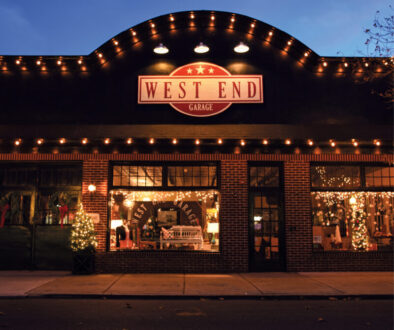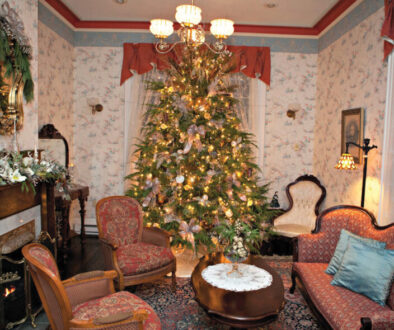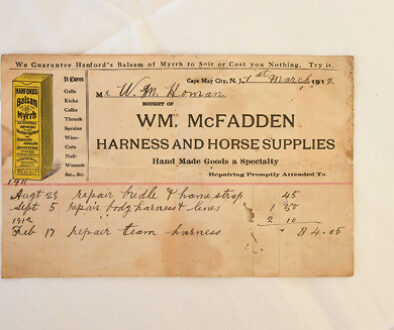Family Ties
The Albeds’ Cape May connection spans decades
We’ve all seen the old-against-new photo comparisons of Cape May street scenes that seem virtually unchanged over the years. With its architecture carefully maintained and seemingly insignificant details as slate curbs and sandstone carriage steps valued and protected, Cape May, to a newcomer, is a bygone era captured in time.
Despite its backdrop of fixed and picturesque streetscapes, the lifestyle and daily events that once unfolded on them have eluded the efforts of even the most caring preservationist, everyday vignettes of a vanished era that only remain vivid in the memories of a scattered few. Laurice Albed is one of the few who remembers; the days in the early 20th century when strolling on the boardwalk was a formal affair, with police asking those who were not dressed properly to go elsewhere. When children anxiously awaited the nightly arrival of Mr. McPherson, who would bring his truck of ponies to the empty lot between Stockton and Gurney Streets and offer pony rides for 25 cents. The Friday nights when Petroff’s hot dog stand would stay open past midnight so practicing Catholics who abstained from eating meat on Fridays could enjoy a late-night treat.


“I want my old Cape May back.” said 86-year-old Laurice Albed as she gazed across her kitchen that remains virtually unchanged since 1869. Against the far wall from where she sat is her home’s original kitchen sink—small, rectangular, complete with antique faucets, still in working order. “I know that when I’m gone, probably the first thing to come out is that sink.”
This is her childhood home—one of the seven Stockton Cottages on Gurney Street, arguably among the most photographed and iconic rows of Victorian houses anywhere. The Albed family was only the second owner in the home’s 150-year history. Purchased by her parents, Samuel and Najla Albed shortly after its original owner died in the 1930s, Laurice and her brother Raymond, who died in 2014, grew up here in the tail end of Cape May’s golden age.
Guests of Laurice don’t have to look far to find other cherished and meticulously maintained remnants of the Cape May she longs for. Behind her, bookending one of the house’s many 19th-century side tables, were two dainty wooden chairs which once served as fitting-room seats at her mother’s Cape May dress shop.
Albed Dress Shop was her mother’s boutique of bridal attire, exquisite lace, and evening wear. And Albed Rugs was her father’s, dealing in imported handcrafted rugs, fine linens, and banquet cloths from the most exotic corners of the globe. The stores were located at opposite ends of the original Cape May Convention Hall, built in 1917.


The centerpiece of Cape May’s nightlife and entertainment that stood over the beach on the site of today’s Convention Hall, it featured live music nightly, a children’s hour of activities, and dance contests among many offerings. In addition to her parents’ shops, the Convention Hall complex also featured an arcade and Ricker’s souvenirs and sundries.
It may seem to today’s resident and visitor that selling such high-end merchandise might not be the best way to make a living in a shore town, especially in an era when the official two-month summer season was only a fraction of today’s extended April-through-December festivities.
“Cape May was a prosperous town in the 1920s and into the 40s,” Laurice said when explaining the success of the shore stores that dealt in luxury items. “We had clientele like Miss Wilbraham who would have her chauffeur bring her to the store to purchase linens and rugs. Gloria Swanson and Edward Everett Horton had visited my father’s store when they were appearing at Cape May Playhouse. Many of the large homes built along Beach Avenue at that time had our rugs, and so did the Colonial Hotel.”
Born in 1893 in the Middle East, Samuel Albed was sent to America at the age of 16 by his parents to prevent him from being subjected to joining the Turkish Army. “My father came to Ellis Island,” Laurice said, “He was a workaholic who started as a peddler. Eventually he started a business in Pennsylvania where he had clients from Cape May who suggested he go there to open a store.” And so he did.
A 26-foot long table of gentlemen’s handkerchiefs, towels, and linens led customers to the rear of the store, where silk and wool rugs were displayed. “My father and Raymond would travel to the Middle East to purchase the merchandise,” Laurice said. “They’d go to India and Pakistan, they’d buy Persian rugs in Iran. In the store, hanging on the wall was a beautiful silk rug with the Koran in Arabic. It was my father’s favorite, and it was not for sale.”

Her mother took the same pride in displaying the wares of her store, which she opened in the mid 1940s. The windows of Albed Dress Shop featured beautifully attired mannequins wearing the latest summer fashions. An on-staff seamstress was present at all times for any quick alterations a lady might need when purchasing a bathing suit or an evening dress to be worn while vacationing.
When looking at those old-against-new photo comparisons of Cape May, there is one key site that sadly will never look as it did a century ago—that being Cape May Convention Hall.
In March of 1962, the Jersey Shore’s landscape had been altered forever with the most devastating storm in its recorded history—a tempest that the US Geological Survey lists as one of the most destructive storms to have ever affected the Mid-Atlantic states. Albed Rugs and Albed Dress Shop were two of its countless casualties, as the already-aged wooden pilings supporting Convention Hall became compromised by the rising, violent sea beneath.
Neither Cape May nor the Albeds were strangers to devastating shore storms. Laurice recalls the hurricane of 1944, which also wreaked havoc along Cape May’s Beach Avenue. “Raymond and I were looking out our third-floor window,” Laurice said, “and we saw piano keys floating down the street from the Convention Hall piano. We were running up and down the steps to tell our mother and our housekeeper what we saw.”


Cape May was particularly hard hit by the ‘62 storm compared with most Jersey shore communities. By the 1950s, the town’s many 19th-century hotels had already declined into a state of constant repair and were falling out of favor for visitors who desired the newer, sleek motels built in the Wildwoods during the postwar era. The infamous March storm seemed to be nature’s insult to injury in a community already struggling to keep up with the times, and its aftermath was the beginning of Cape May’s darkest economic period before its Victorian renaissance in the mid ‘70s.
“The ’62 storm hit my father very emotionally,” Laurice remembers. “His store had already been there for over 45 years. When my father and Raymond returned from looking at the store after the storm, he said, ‘We’re not going to have a store this summer.’ My mother had already ordered bathing suits and summer clothing for her store. The merchandise could not be returned. She ended up on Decatur Street where Uniquely Yours is now. My father rented the space where Blue Moon Pizza is just to sell whatever he could salvage from the store.”
In a desperate attempt to recover from the crippling storm, Cape May’s city fathers paid a visit to Samuel Albed. “One Sunday, Mayor Wright, Judge Dwyer, and a third man came to the house looking for my father. I told them my mother and father were at church, and invited them in to wait. When my parents came home, my mother was in the corner saying to me ‘I wonder what these men want?’ They said to my father, ‘We have no money. The city has no money. We want to rebuild Convention Hall, can you help us?’ My mother stood in the corner and shook her head no. My father told them he could not do it because he was building a store in Wayne, Pennsylvania. It’s good he said no because in five years he was dead.”



The store in Wayne was built to reflect the family’s love of Cape May, with an exterior facade that replicated the architectural details of the Convention Hall. After the death of their father, Raymond went on to manage the store, while Laurice attended University of Delaware to study elementary education and enjoyed a 13-year career as a teacher in Haverford before working in the elementary education program at Villanova University.
Albed Rug Company in Wayne is still in operation today, managed by Raymond Albed Jr., his sister Nancy, and his wife Michelle. Proudly displayed on the wall of Albed Rugs is Samuel Albed’s favorite handcrafted silk rug with the Koran in Arabic—a family heirloom that hangs as testimony to more than a century of hard work and pride.
The youngest of the Albed family is Raymond Jr. and Michelle’s only son, Tommy, who has decided to not to pursue the family business. “He just graduated from the business school,” said Laurice, “I don’t think he wants the family business. If my father and Raymond were alive, I think they’d be very upset. But he is pursuing what he wants.”



Although the family business is still enjoying success as one of the Delaware Valley’s premier showrooms for imported and fine-quality rugs, Michelle Albed shares Laurice’s feelings about the eventual end of an era. “It will be sad to see the Albed Rug Company not live on,” Michelle said. “But when we eventually close, it will have been an amazing ride.” An amazing ride indeed for a family business that has successfully surpassed the century mark while playing a principal role in the many chapters of Cape May’s rich history.
As for having her old Cape May back, Laurice lights up when pointing out some of the current shops that she sees as returning the town to the standards of excellence for which her mother and father strived. “The shop in Congress Hall carries some beautiful clothing,” Laurice said. “And so does Cash and Clive. And of course Casale’s Shoes has some of the finest quality shoes around.”
Each spring when Laurice returns to Cape May from Pennsylvania, she feels as if she is once again the little girl who eagerly awaited Mr. McPherson’s nightly pony rides and savored Petroff’s famous hot dogs. “Each spring I get emotional when I come over the bridge,” Laurice said. “To me, I am coming home. There have been so many changes I have seen over the years. Some of the newer construction upsets me, but there have been a lot of good changes, like the rebuilding of the beaches and the restoration of Congress Hall. I’ll always love this town.”



